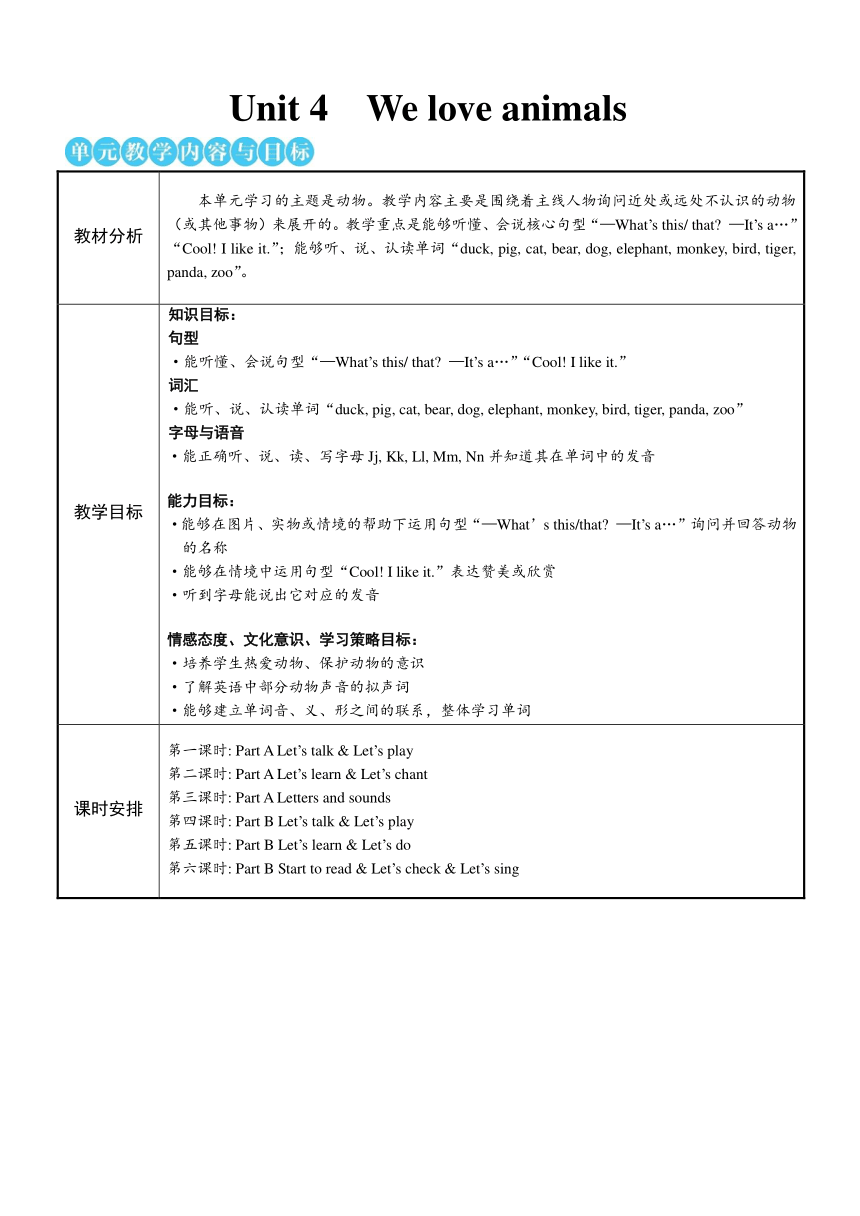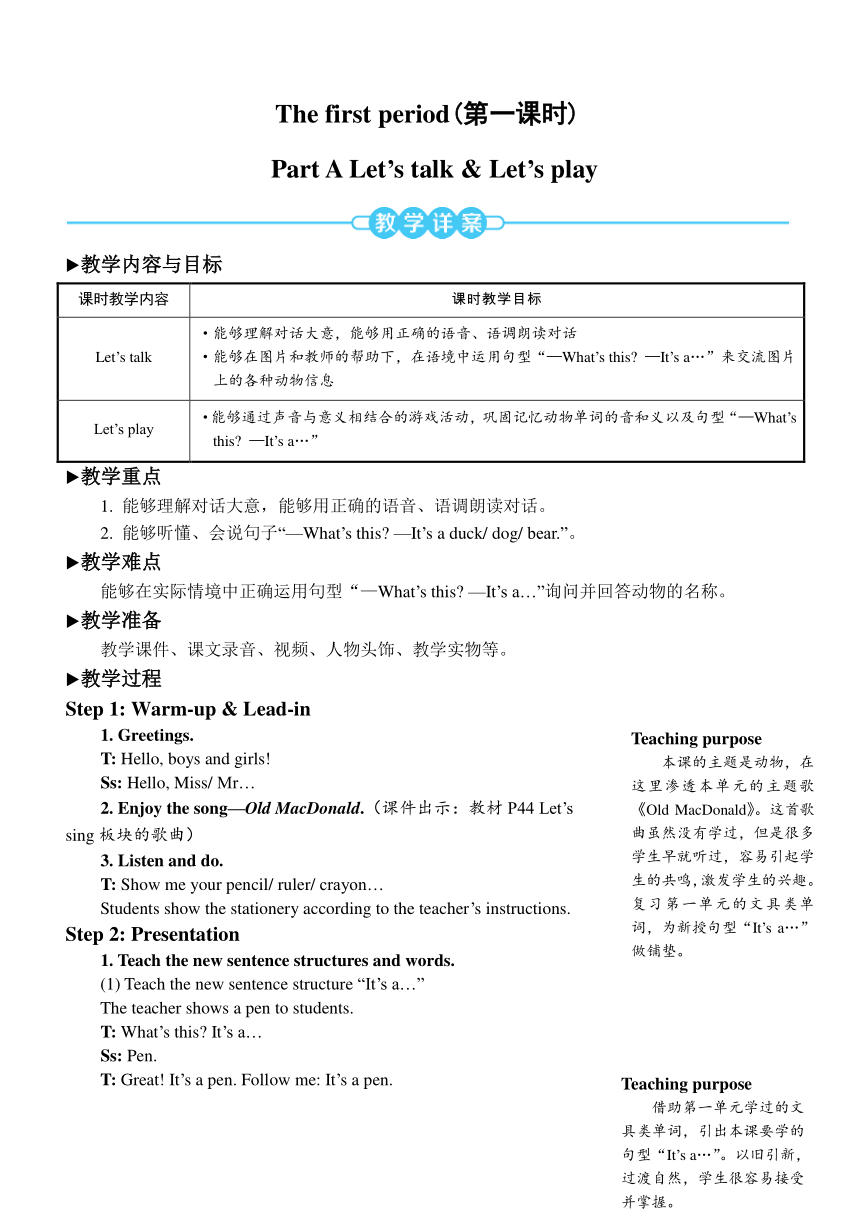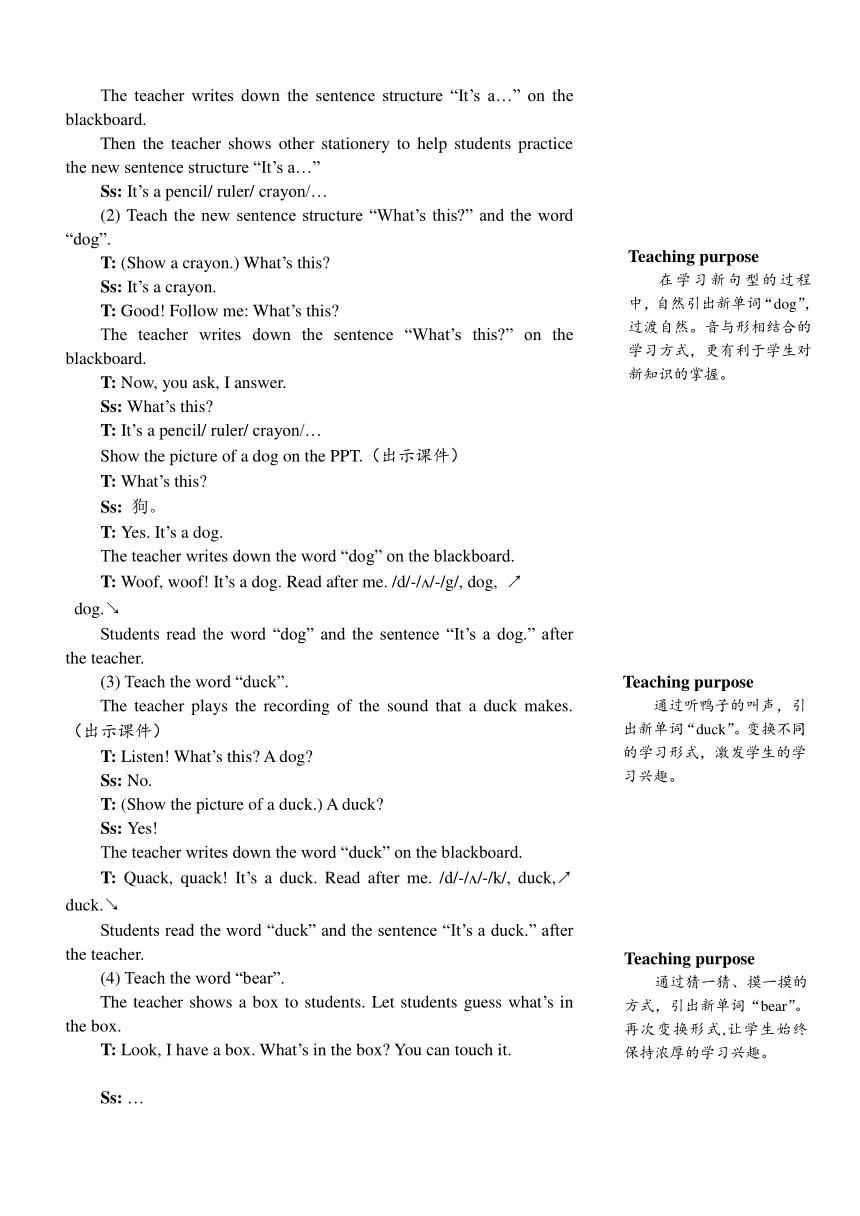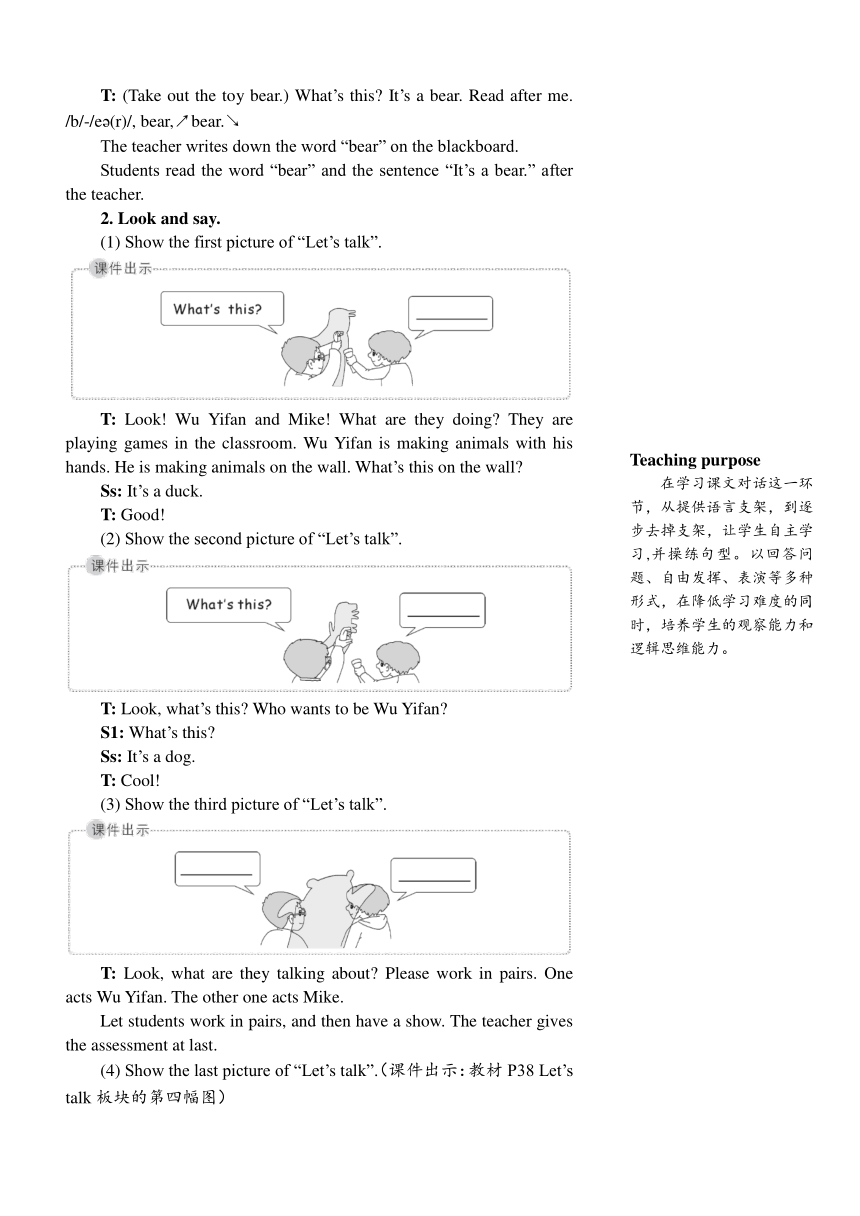Unit 4 We love animalsPart A Let’s talk教案(含反思,详案与简案)
文档属性
| 名称 | Unit 4 We love animalsPart A Let’s talk教案(含反思,详案与简案) |  | |
| 格式 | zip | ||
| 文件大小 | 351.3KB | ||
| 资源类型 | 教案 | ||
| 版本资源 | 人教版(PEP) | ||
| 科目 | 英语 | ||
| 更新时间 | 2020-07-10 11:10:06 | ||
图片预览




文档简介
Unit
4
We
love
animals
教材分析
本单元学习的主题是动物。教学内容主要是围绕着主线人物询问近处或远处不认识的动物(或其他事物)来展开的。教学重点是能够听懂、会说核心句型“—What’s
this/
that?
—It’s
a…”“Cool!
I
like
it.”;能够听、说、认读单词“duck,
pig,
cat,
bear,
dog,
elephant,
monkey,
bird,
tiger,
panda,
zoo”。
教学目标
知识目标:句型·能听懂、会说句型“—What’s
this/
that?
—It’s
a…”“Cool!
I
like
it.”词汇·能听、说、认读单词“duck,
pig,
cat,
bear,
dog,
elephant,
monkey,
bird,
tiger,
panda,
zoo”字母与语音·能正确听、说、读、写字母Jj,
Kk,
Ll,
Mm,
Nn并知道其在单词中的发音能力目标:·能够在图片、实物或情境的帮助下运用句型“—What’s
this/that?
—It’s
a…”询问并回答动物的名称·能够在情境中运用句型“Cool!
I
like
it.”表达赞美或欣赏·听到字母能说出它对应的发音情感态度、文化意识、学习策略目标:·培养学生热爱动物、保护动物的意识·了解英语中部分动物声音的拟声词·能够建立单词音、义、形之间的联系,整体学习单词
课时安排
第一课时:
Part
A
Let’s
talk
&
Let’s
play第二课时:
Part
A
Let’s
learn
&
Let’s
chant第三课时:
Part
A
Letters
and
sounds第四课时:
Part
B
Let’s
talk
&
Let’s
play第五课时:
Part
B
Let’s
learn
&
Let’s
do第六课时:
Part
B
Start
to
read
&
Let’s
check
&
Let’s
sing
The
first
period(第一课时)
Part
A
Let’s
talk
&
Let’s
play
?教学内容与目标
课时教学内容
课时教学目标
Let’s
talk
·能够理解对话大意,能够用正确的语音、语调朗读对话·能够在图片和教师的帮助下,在语境中运用句型“—What’s
this?
—It’s
a…”来交流图片上的各种动物信息
Let’s
play
·能够通过声音与意义相结合的游戏活动,巩固记忆动物单词的音和义以及句型“—What’s
this?
—It’s
a…”
?教学重点
1.
能够理解对话大意,能够用正确的语音、语调朗读对话。
2.
能够听懂、会说句子“—What’s
this?
—It’s
a
duck/
dog/
bear.”。
?教学难点
能够在实际情境中正确运用句型“—What’s
this?
—It’s
a…”询问并回答动物的名称。
?教学准备
教学课件、课文录音、视频、人物头饰、教学实物等。
?教学过程
Step
1:
Warm-up
&
Lead-in
1.
Greetings.
T:
Hello,
boys
and
girls!
Ss:
Hello,
Miss/
Mr…
2.
Enjoy
the
song—Old
MacDonald.(课件出示:教材P44
Let’s
sing板块的歌曲)
3.
Listen
and
do.
T:
Show
me
your
pencil/
ruler/
crayon…
Students
show
the
stationery
according
to
the
teacher’s
instructions.
Step
2:
Presentation
1.
Teach
the
new
sentence
structures
and
words.
(1)
Teach
the
new
sentence
structure
“It’s
a…”
The
teacher
shows
a
pen
to
students.
T:
What’s
this?
It’s
a…
Ss:
Pen.
T:
Great!
It’s
a
pen.
Follow
me:
It’s
a
pen.
The
teacher
writes
down
the
sentence
structure
“It’s
a…”
on
the
blackboard.
Then
the
teacher
shows
other
stationery
to
help
students
practice
the
new
sentence
structure
“It’s
a…”
Ss:
It’s
a
pencil/
ruler/
crayon/…
(2)
Teach
the
new
sentence
structure
“What’s
this?”
and
the
word
“dog”.
T:
(Show
a
crayon.)
What’s
this?
Ss:
It’s
a
crayon.
T:
Good!
Follow
me:
What’s
this?
The
teacher
writes
down
the
sentence
“What’s
this?”
on
the
blackboard.
T:
Now,
you
ask,
I
answer.
Ss:
What’s
this?
T:
It’s
a
pencil/
ruler/
crayon/…
Show
the
picture
of
a
dog
on
the
PPT.(出示课件)
T:
What’s
this?
Ss:
狗。
T:
Yes.
It’s
a
dog.
The
teacher
writes
down
the
word
“dog”
on
the
blackboard.
T:
Woof,
woof!
It’s
a
dog.
Read
after
me.
/d/-/?/-/g/,
dog,
↗
dog.↘?
Students
read
the
word
“dog”
and
the
sentence
“It’s
a
dog.”
after
the
teacher.
(3)
Teach
the
word
“duck”.
The
teacher
plays
the
recording
of
the
sound
that
a
duck
makes.
(出示课件)
T:
Listen!
What’s
this?
A
dog?
Ss:
No.
T:
(Show
the
picture
of
a
duck.)
A
duck?
Ss:
Yes!
The
teacher
writes
down
the
word
“duck”
on
the
blackboard.
T:
Quack,
quack!
It’s
a
duck.
Read
after
me.
/d/-/?/-/k/,
duck,↗
duck.↘
Students
read
the
word
“duck”
and
the
sentence
“It’s
a
duck.”
after
the
teacher.
(4)
Teach
the
word
“bear”.
The
teacher
shows
a
box
to
students.
Let
students
guess
what’s
in
the
box.
T:
Look,
I
have
a
box.
What’s
in
the
box?
You
can
touch
it.
Ss:
…
T:
(Take
out
the
toy
bear.)
What’s
this?
It’s
a
bear.
Read
after
me.
/b/-/e?(r)/,
bear,↗bear.↘?
The
teacher
writes
down
the
word
“bear”
on
the
blackboard.
Students
read
the
word
“bear”
and
the
sentence
“It’s
a
bear.”
after
the
teacher.
2.
Look
and
say.
(1)
Show
the
first
picture
of
“Let’s
talk”.
T:
Look!
Wu
Yifan
and
Mike!
What
are
they
doing?
They
are
playing
games
in
the
classroom.
Wu
Yifan
is
making
animals
with
his
hands.
He
is
making
animals
on
the
wall.
What’s
this
on
the
wall?
Ss:
It’s
a
duck.
T:
Good!
(2)
Show
the
second
picture
of
“Let’s
talk”.
T:
Look,
what’s
this?
Who
wants
to
be
Wu
Yifan?
S1:
What’s
this?
Ss:
It’s
a
dog.
T:
Cool!
(3)
Show
the
third
picture
of
“Let’s
talk”.
T:
Look,
what
are
they
talking
about?
Please
work
in
pairs.
One
acts
Wu
Yifan.
The
other
one
acts
Mike.
Let
students
work
in
pairs,
and
then
have
a
show.
The
teacher
gives
the
assessment
at
last.
(4)
Show
the
last
picture
of
“Let’s
talk”.(课件出示:教材P38
Let’s
talk板块的第四幅图)
T:
Who
is
that?
Ss:
Zoom!
T:
Oh,
it’s
Zoom.
3.
Read
and
act.
(1)
The
teacher
plays
the
cartoon.(课件出示:教材P38
Let’s
talk板块的动画)Ask
students
to
watch
the
cartoon
and
read
after
it.
Let
students
pay
attention
to
the
pronunciation
and
the
intonation.
(2)
Let
students
read
the
dialogue
by
themselves.
(3)
Let
students
practice
the
dialogue
in
pairs,
and
then
wear
the
headdresses
to
act
out
the
dialogue
in
class.
Step
3:
Practice
1.
Make
a
chant.
The
teacher
gives
an
example
to
students.
Then
let
students
make
a
chant
together.
2.
Let’s
play.
(1)
Show
the
pictures
of
“duck,
dog,
bear”
one
by
one.(出示课件)
Do
the
hand
shadows
and
imitate
the
sounds
of
the
three
animals.
Let
students
ask
and
answer
with
the
sentence
structures
“—What’s
this?
—It’s
a
duck/
dog/
bear.”
(2)
Pair
work.
Let
students
work
in
pairs
to
practice
the
dialogue
of
“Let’s
play”.
(3)
Show
time.
Ask
one
student
to
come
to
the
front
and
imitate
the
sounds
of
the
animals,
and
the
other
students
guess
by
saying
“It’s
a…”
S1:
Woof!
Woof!
What’s
this?
Ss:
It’s
a
dog.
…
Step
4:
Consolidation
&
Extension
1.
What
is
on
the
farm?
Show
the
picture
of
old
MacDonald
and
his
farm
on
the
PPT.(课件出示:MacDonald和他的农场)Students
can
see
part
of
the
dog/
duck/
bear
in
the
picture.
T:(课件出示:一只狗在吃狗粮)
Look!
What’s
this?
Ss:
It’s
a
dog.
T:
Wow,
you
are
so
clever!
(课件出示:地上有一些鸭子的脚印)
What’s
this?
Ss:
It’s
a
duck.
T:
(课件出示:
一只熊躲在树洞里,只露出尾巴)
Look!
What’s
this?
Ss:
It’s
a
bear.
2.
Practice
in
pairs
and
show
in
class.
Students
practice
the
sentence
structures
“—What’s
this?
—
It’s
a…”
in
pairs.
S1:
(Point
to
the
picture
of
the
dog
on
the
farm.)
Look!
What’s
this?
S2:
It’s
a
dog.
S1:
(Point
to
the…)
Look!
What’s
this?
S2:
…
The
teacher
chooses
several
pairs
of
students
to
show
their
dialogues
in
class,
and
gives
some
stickers
to
the
students
who
do
a
good
job.
?板书设计
?作业设计
1.
Practice
the
dialogue
of
“Let’s
talk”.
2.
Practice
the
sentence
structures
by
playing
the
hand
shadow
game
with
your
family
members.
3.
Do
the
exercises.
?教学反思
1.
教学设计精心巧妙,层层递进,由易到难,易于操作,始终使学生保持浓厚的学习兴趣。
2.
新知的学习尽可能地联系旧知,以旧引新,降低了学生学习的难度,帮助学生更好地理解所学知识。
3.
板书设计配合图片展示,一目了然,重点突出,对课堂教学起到了很好的辅助作用。
?Teaching
Contents
&
Teaching
Aims
Let’s
talk
·Be
able
to
understand
the
main
idea
of
the
dialogue
and
read
the
dialogue
with
correct
pronunciation
and
intonation.
·Be
able
to
use
the
sentence
structures
“—What’s
this?
—It’s
a…”
to
get
information
of
animals
in
context
with
the
help
of
the
teacher
and
the
pictures.
Let’s
play
·Be
able
to
consolidate
the
words
“duck,
dog,
bear”
and
the
sentence
structures
“—What’s
this?
·—It’s
a…”
through
the
hand
shadow
game
and
other
activities.
?Teaching
Priorities
·Be
able
to
understand
the
main
idea
of
the
dialogue
and
read
the
dialogue
with
correct
pronunciation
and
intonation.
·Be
able
to
understand
and
say
the
sentences
“—What’s
this?
—It’s
a
duck/
dog/
bear.”
?Teaching
Difficulties
·Be
able
to
use
the
sentence
structures
“—What’s
this?
—It’s
a…”
to
ask
and
answer
the
name
of
the
animals
correctly
in
real
situations.
?Teaching
Procedures
Teaching
Stages
Teacher’
s
Activities
Students’
Activities
Teaching
Purposes
Warm-up
&Lead-in
1.
Greetings.2.
Enjoy
the
song—Old
MacDonald.3.
Listen
and
do.
1.
Greetings.2.
Listen
to
the
song.3.
Show
the
stationery
according
to
the
teacher’s
instructions.
Stimulate
students’
interest
in
learning
and
lead
in
the
topic
of
this
unit.
Review
the
words
about
stationery
which
students
have
learned.
Presentation
1.
Teach
the
new
sentence
structures
and
words.(1)
Teach
the
new
sentence
structure
“It’s
a…”(2)
Teach
the
new
sentence
structure
“What’s
this?”
and
the
word
“dog”.(3)
Teach
the
word
“duck”.(4)
Teach
the
word
“bear”.
(1)
Learn
the
new
sentence
structure
“It’s
a…”
by
some
stationery.(2)
Learn
the
new
sentence
structure
“What’s
this?”
and
the
word
“dog”.(3)
Learn
the
word
“duck”.(4)
Learn
the
word
“bear”.
Create
a
good
English
learning
atmosphere.
Lead
students
to
understand
and
learn
the
new
sentence
structures
and
words
through
different
learning
ways.
2.
Look
and
say.Show
the
pictures
of
“Let’s
talk”
one
by
one
and
teach
the
dialogue
step
by
step.
Observe
the
pictures
and
talk
about
them
with
the
teacher.
Learn
the
dialogue.
Lead
students
to
learn
new
sentence
structures
gradually.
Reduce
the
difficulty
of
learning.
And
cultivate
students’
observation
and
logical
thinking
ability.
3.
Read
and
act.Play
the
cartoon.
Read
the
dialogue
after
the
cartoon
and
read
by
themselves.
Practice
the
dialogue
in
pairs
and
act
it
out.
Make
sure
that
students
can
read
the
dialogue
correctly
and
fluently.
Deepen
their
understanding
of
the
dialogue.
Practice
1.
Make
a
chant.Give
an
example.
Make
a
chant
together.
Use
the
chant
to
arouse
students’
learning
interest.
Practice
the
key
words
and
sentence
structures
by
the
interesting
games.
2.
Let’s
play.Show
the
pictures
one
by
one.
Do
the
hand
shadows
and
imitate
the
sounds.
Follow
the
teacher
to
ask
and
answer
with
the
sentence
structures
“—What’s
this?
—
It’s
a
duck/
dog/
bear.”
Consolidation&Extension
1.
What
is
on
the
farm?Show
some
pictures
and
ask
some
questions.
Look
at
the
pictures
and
answer
the
questions.
Create
the
language
environment
with
old
MacDonald’s
farm
to
echo
with
the
beginning
and
arouse
students’
great
interest
in
practicing
the
new
sentence
structures.
2.
Let
students
work
in
pairs
and
show
in
class.Give
some
stickers
to
the
students
who
do
a
good
job.
Work
in
pairs
to
practice
the
sentence
structures
and
show
in
class.
Homework
1.
Practice
the
dialogue
of
“Let’s
talk”.2.
Practice
the
sentence
structures
by
playing
the
hand
shadow
game
with
your
family
members.3.
Do
the
exercises.
Teaching
purpose
本课的主题是动物,在这里渗透本单元的主题歌《Old
MacDonald》。这首歌曲虽然没有学过,但是很多学生早就听过,容易引起学生的共鸣,激发学生的兴趣。复习第一单元的文具类单词,为新授句型“It’s
a…”做铺垫。
Teaching
purpose
借助第一单元学过的文具类单词,引出本课要学的句型“It’s
a…”。以旧引新,过渡自然,学生很容易接受并掌握。
Teaching
purpose
在学习新句型的过程中,自然引出新单词“dog”,过渡自然。音与形相结合的学习方式,更有利于学生对新知识的掌握。
Teaching
purpose
通过听鸭子的叫声,引出新单词“duck”。变换不同的学习形式,激发学生的学习兴趣。
Teaching
purpose
通过猜一猜、摸一摸的方式,引出新单词“bear”。再次变换形式,让学生始终保持浓厚的学习兴趣。
Teaching
purpose
在学习课文对话这一环节,从提供语言支架,到逐步去掉支架,让学生自主学习,并操练句型。以回答问题、自由发挥、表演等多种形式,在降低学习难度的同时,培养学生的观察能力和逻辑思维能力。
Teaching
purpose
播放录音,学生听录音跟读。引导学生按照正确的语音、语调朗读对话,并能在小组中进行角色扮演。进一步加深学生对对话的理解,以及对新学单词和句型的掌握。
Teaching
purpose
以朗朗上口的chant形式,帮助学生巩固新知,让学生在韵律中,多回合、多层次地操练,不断加强对新知的记忆。
Teaching
purpose
通过手影游戏,在一问一答间,进一步加深学生对句型和动物单词的理解,同时让课堂教学充满趣味性。
Teaching
purpose
在导入环节,学生聆听《Old
MacDonald》这首歌;在拓展环节,再次围绕MacDonald的农场创设语音情境,对重点句型进行拓展操练,首尾照应。让学生找出隐藏在农场中的动物,能够极大地调动学生的积极性。
4
We
love
animals
教材分析
本单元学习的主题是动物。教学内容主要是围绕着主线人物询问近处或远处不认识的动物(或其他事物)来展开的。教学重点是能够听懂、会说核心句型“—What’s
this/
that?
—It’s
a…”“Cool!
I
like
it.”;能够听、说、认读单词“duck,
pig,
cat,
bear,
dog,
elephant,
monkey,
bird,
tiger,
panda,
zoo”。
教学目标
知识目标:句型·能听懂、会说句型“—What’s
this/
that?
—It’s
a…”“Cool!
I
like
it.”词汇·能听、说、认读单词“duck,
pig,
cat,
bear,
dog,
elephant,
monkey,
bird,
tiger,
panda,
zoo”字母与语音·能正确听、说、读、写字母Jj,
Kk,
Ll,
Mm,
Nn并知道其在单词中的发音能力目标:·能够在图片、实物或情境的帮助下运用句型“—What’s
this/that?
—It’s
a…”询问并回答动物的名称·能够在情境中运用句型“Cool!
I
like
it.”表达赞美或欣赏·听到字母能说出它对应的发音情感态度、文化意识、学习策略目标:·培养学生热爱动物、保护动物的意识·了解英语中部分动物声音的拟声词·能够建立单词音、义、形之间的联系,整体学习单词
课时安排
第一课时:
Part
A
Let’s
talk
&
Let’s
play第二课时:
Part
A
Let’s
learn
&
Let’s
chant第三课时:
Part
A
Letters
and
sounds第四课时:
Part
B
Let’s
talk
&
Let’s
play第五课时:
Part
B
Let’s
learn
&
Let’s
do第六课时:
Part
B
Start
to
read
&
Let’s
check
&
Let’s
sing
The
first
period(第一课时)
Part
A
Let’s
talk
&
Let’s
play
?教学内容与目标
课时教学内容
课时教学目标
Let’s
talk
·能够理解对话大意,能够用正确的语音、语调朗读对话·能够在图片和教师的帮助下,在语境中运用句型“—What’s
this?
—It’s
a…”来交流图片上的各种动物信息
Let’s
play
·能够通过声音与意义相结合的游戏活动,巩固记忆动物单词的音和义以及句型“—What’s
this?
—It’s
a…”
?教学重点
1.
能够理解对话大意,能够用正确的语音、语调朗读对话。
2.
能够听懂、会说句子“—What’s
this?
—It’s
a
duck/
dog/
bear.”。
?教学难点
能够在实际情境中正确运用句型“—What’s
this?
—It’s
a…”询问并回答动物的名称。
?教学准备
教学课件、课文录音、视频、人物头饰、教学实物等。
?教学过程
Step
1:
Warm-up
&
Lead-in
1.
Greetings.
T:
Hello,
boys
and
girls!
Ss:
Hello,
Miss/
Mr…
2.
Enjoy
the
song—Old
MacDonald.(课件出示:教材P44
Let’s
sing板块的歌曲)
3.
Listen
and
do.
T:
Show
me
your
pencil/
ruler/
crayon…
Students
show
the
stationery
according
to
the
teacher’s
instructions.
Step
2:
Presentation
1.
Teach
the
new
sentence
structures
and
words.
(1)
Teach
the
new
sentence
structure
“It’s
a…”
The
teacher
shows
a
pen
to
students.
T:
What’s
this?
It’s
a…
Ss:
Pen.
T:
Great!
It’s
a
pen.
Follow
me:
It’s
a
pen.
The
teacher
writes
down
the
sentence
structure
“It’s
a…”
on
the
blackboard.
Then
the
teacher
shows
other
stationery
to
help
students
practice
the
new
sentence
structure
“It’s
a…”
Ss:
It’s
a
pencil/
ruler/
crayon/…
(2)
Teach
the
new
sentence
structure
“What’s
this?”
and
the
word
“dog”.
T:
(Show
a
crayon.)
What’s
this?
Ss:
It’s
a
crayon.
T:
Good!
Follow
me:
What’s
this?
The
teacher
writes
down
the
sentence
“What’s
this?”
on
the
blackboard.
T:
Now,
you
ask,
I
answer.
Ss:
What’s
this?
T:
It’s
a
pencil/
ruler/
crayon/…
Show
the
picture
of
a
dog
on
the
PPT.(出示课件)
T:
What’s
this?
Ss:
狗。
T:
Yes.
It’s
a
dog.
The
teacher
writes
down
the
word
“dog”
on
the
blackboard.
T:
Woof,
woof!
It’s
a
dog.
Read
after
me.
/d/-/?/-/g/,
dog,
↗
dog.↘?
Students
read
the
word
“dog”
and
the
sentence
“It’s
a
dog.”
after
the
teacher.
(3)
Teach
the
word
“duck”.
The
teacher
plays
the
recording
of
the
sound
that
a
duck
makes.
(出示课件)
T:
Listen!
What’s
this?
A
dog?
Ss:
No.
T:
(Show
the
picture
of
a
duck.)
A
duck?
Ss:
Yes!
The
teacher
writes
down
the
word
“duck”
on
the
blackboard.
T:
Quack,
quack!
It’s
a
duck.
Read
after
me.
/d/-/?/-/k/,
duck,↗
duck.↘
Students
read
the
word
“duck”
and
the
sentence
“It’s
a
duck.”
after
the
teacher.
(4)
Teach
the
word
“bear”.
The
teacher
shows
a
box
to
students.
Let
students
guess
what’s
in
the
box.
T:
Look,
I
have
a
box.
What’s
in
the
box?
You
can
touch
it.
Ss:
…
T:
(Take
out
the
toy
bear.)
What’s
this?
It’s
a
bear.
Read
after
me.
/b/-/e?(r)/,
bear,↗bear.↘?
The
teacher
writes
down
the
word
“bear”
on
the
blackboard.
Students
read
the
word
“bear”
and
the
sentence
“It’s
a
bear.”
after
the
teacher.
2.
Look
and
say.
(1)
Show
the
first
picture
of
“Let’s
talk”.
T:
Look!
Wu
Yifan
and
Mike!
What
are
they
doing?
They
are
playing
games
in
the
classroom.
Wu
Yifan
is
making
animals
with
his
hands.
He
is
making
animals
on
the
wall.
What’s
this
on
the
wall?
Ss:
It’s
a
duck.
T:
Good!
(2)
Show
the
second
picture
of
“Let’s
talk”.
T:
Look,
what’s
this?
Who
wants
to
be
Wu
Yifan?
S1:
What’s
this?
Ss:
It’s
a
dog.
T:
Cool!
(3)
Show
the
third
picture
of
“Let’s
talk”.
T:
Look,
what
are
they
talking
about?
Please
work
in
pairs.
One
acts
Wu
Yifan.
The
other
one
acts
Mike.
Let
students
work
in
pairs,
and
then
have
a
show.
The
teacher
gives
the
assessment
at
last.
(4)
Show
the
last
picture
of
“Let’s
talk”.(课件出示:教材P38
Let’s
talk板块的第四幅图)
T:
Who
is
that?
Ss:
Zoom!
T:
Oh,
it’s
Zoom.
3.
Read
and
act.
(1)
The
teacher
plays
the
cartoon.(课件出示:教材P38
Let’s
talk板块的动画)Ask
students
to
watch
the
cartoon
and
read
after
it.
Let
students
pay
attention
to
the
pronunciation
and
the
intonation.
(2)
Let
students
read
the
dialogue
by
themselves.
(3)
Let
students
practice
the
dialogue
in
pairs,
and
then
wear
the
headdresses
to
act
out
the
dialogue
in
class.
Step
3:
Practice
1.
Make
a
chant.
The
teacher
gives
an
example
to
students.
Then
let
students
make
a
chant
together.
2.
Let’s
play.
(1)
Show
the
pictures
of
“duck,
dog,
bear”
one
by
one.(出示课件)
Do
the
hand
shadows
and
imitate
the
sounds
of
the
three
animals.
Let
students
ask
and
answer
with
the
sentence
structures
“—What’s
this?
—It’s
a
duck/
dog/
bear.”
(2)
Pair
work.
Let
students
work
in
pairs
to
practice
the
dialogue
of
“Let’s
play”.
(3)
Show
time.
Ask
one
student
to
come
to
the
front
and
imitate
the
sounds
of
the
animals,
and
the
other
students
guess
by
saying
“It’s
a…”
S1:
Woof!
Woof!
What’s
this?
Ss:
It’s
a
dog.
…
Step
4:
Consolidation
&
Extension
1.
What
is
on
the
farm?
Show
the
picture
of
old
MacDonald
and
his
farm
on
the
PPT.(课件出示:MacDonald和他的农场)Students
can
see
part
of
the
dog/
duck/
bear
in
the
picture.
T:(课件出示:一只狗在吃狗粮)
Look!
What’s
this?
Ss:
It’s
a
dog.
T:
Wow,
you
are
so
clever!
(课件出示:地上有一些鸭子的脚印)
What’s
this?
Ss:
It’s
a
duck.
T:
(课件出示:
一只熊躲在树洞里,只露出尾巴)
Look!
What’s
this?
Ss:
It’s
a
bear.
2.
Practice
in
pairs
and
show
in
class.
Students
practice
the
sentence
structures
“—What’s
this?
—
It’s
a…”
in
pairs.
S1:
(Point
to
the
picture
of
the
dog
on
the
farm.)
Look!
What’s
this?
S2:
It’s
a
dog.
S1:
(Point
to
the…)
Look!
What’s
this?
S2:
…
The
teacher
chooses
several
pairs
of
students
to
show
their
dialogues
in
class,
and
gives
some
stickers
to
the
students
who
do
a
good
job.
?板书设计
?作业设计
1.
Practice
the
dialogue
of
“Let’s
talk”.
2.
Practice
the
sentence
structures
by
playing
the
hand
shadow
game
with
your
family
members.
3.
Do
the
exercises.
?教学反思
1.
教学设计精心巧妙,层层递进,由易到难,易于操作,始终使学生保持浓厚的学习兴趣。
2.
新知的学习尽可能地联系旧知,以旧引新,降低了学生学习的难度,帮助学生更好地理解所学知识。
3.
板书设计配合图片展示,一目了然,重点突出,对课堂教学起到了很好的辅助作用。
?Teaching
Contents
&
Teaching
Aims
Let’s
talk
·Be
able
to
understand
the
main
idea
of
the
dialogue
and
read
the
dialogue
with
correct
pronunciation
and
intonation.
·Be
able
to
use
the
sentence
structures
“—What’s
this?
—It’s
a…”
to
get
information
of
animals
in
context
with
the
help
of
the
teacher
and
the
pictures.
Let’s
play
·Be
able
to
consolidate
the
words
“duck,
dog,
bear”
and
the
sentence
structures
“—What’s
this?
·—It’s
a…”
through
the
hand
shadow
game
and
other
activities.
?Teaching
Priorities
·Be
able
to
understand
the
main
idea
of
the
dialogue
and
read
the
dialogue
with
correct
pronunciation
and
intonation.
·Be
able
to
understand
and
say
the
sentences
“—What’s
this?
—It’s
a
duck/
dog/
bear.”
?Teaching
Difficulties
·Be
able
to
use
the
sentence
structures
“—What’s
this?
—It’s
a…”
to
ask
and
answer
the
name
of
the
animals
correctly
in
real
situations.
?Teaching
Procedures
Teaching
Stages
Teacher’
s
Activities
Students’
Activities
Teaching
Purposes
Warm-up
&Lead-in
1.
Greetings.2.
Enjoy
the
song—Old
MacDonald.3.
Listen
and
do.
1.
Greetings.2.
Listen
to
the
song.3.
Show
the
stationery
according
to
the
teacher’s
instructions.
Stimulate
students’
interest
in
learning
and
lead
in
the
topic
of
this
unit.
Review
the
words
about
stationery
which
students
have
learned.
Presentation
1.
Teach
the
new
sentence
structures
and
words.(1)
Teach
the
new
sentence
structure
“It’s
a…”(2)
Teach
the
new
sentence
structure
“What’s
this?”
and
the
word
“dog”.(3)
Teach
the
word
“duck”.(4)
Teach
the
word
“bear”.
(1)
Learn
the
new
sentence
structure
“It’s
a…”
by
some
stationery.(2)
Learn
the
new
sentence
structure
“What’s
this?”
and
the
word
“dog”.(3)
Learn
the
word
“duck”.(4)
Learn
the
word
“bear”.
Create
a
good
English
learning
atmosphere.
Lead
students
to
understand
and
learn
the
new
sentence
structures
and
words
through
different
learning
ways.
2.
Look
and
say.Show
the
pictures
of
“Let’s
talk”
one
by
one
and
teach
the
dialogue
step
by
step.
Observe
the
pictures
and
talk
about
them
with
the
teacher.
Learn
the
dialogue.
Lead
students
to
learn
new
sentence
structures
gradually.
Reduce
the
difficulty
of
learning.
And
cultivate
students’
observation
and
logical
thinking
ability.
3.
Read
and
act.Play
the
cartoon.
Read
the
dialogue
after
the
cartoon
and
read
by
themselves.
Practice
the
dialogue
in
pairs
and
act
it
out.
Make
sure
that
students
can
read
the
dialogue
correctly
and
fluently.
Deepen
their
understanding
of
the
dialogue.
Practice
1.
Make
a
chant.Give
an
example.
Make
a
chant
together.
Use
the
chant
to
arouse
students’
learning
interest.
Practice
the
key
words
and
sentence
structures
by
the
interesting
games.
2.
Let’s
play.Show
the
pictures
one
by
one.
Do
the
hand
shadows
and
imitate
the
sounds.
Follow
the
teacher
to
ask
and
answer
with
the
sentence
structures
“—What’s
this?
—
It’s
a
duck/
dog/
bear.”
Consolidation&Extension
1.
What
is
on
the
farm?Show
some
pictures
and
ask
some
questions.
Look
at
the
pictures
and
answer
the
questions.
Create
the
language
environment
with
old
MacDonald’s
farm
to
echo
with
the
beginning
and
arouse
students’
great
interest
in
practicing
the
new
sentence
structures.
2.
Let
students
work
in
pairs
and
show
in
class.Give
some
stickers
to
the
students
who
do
a
good
job.
Work
in
pairs
to
practice
the
sentence
structures
and
show
in
class.
Homework
1.
Practice
the
dialogue
of
“Let’s
talk”.2.
Practice
the
sentence
structures
by
playing
the
hand
shadow
game
with
your
family
members.3.
Do
the
exercises.
Teaching
purpose
本课的主题是动物,在这里渗透本单元的主题歌《Old
MacDonald》。这首歌曲虽然没有学过,但是很多学生早就听过,容易引起学生的共鸣,激发学生的兴趣。复习第一单元的文具类单词,为新授句型“It’s
a…”做铺垫。
Teaching
purpose
借助第一单元学过的文具类单词,引出本课要学的句型“It’s
a…”。以旧引新,过渡自然,学生很容易接受并掌握。
Teaching
purpose
在学习新句型的过程中,自然引出新单词“dog”,过渡自然。音与形相结合的学习方式,更有利于学生对新知识的掌握。
Teaching
purpose
通过听鸭子的叫声,引出新单词“duck”。变换不同的学习形式,激发学生的学习兴趣。
Teaching
purpose
通过猜一猜、摸一摸的方式,引出新单词“bear”。再次变换形式,让学生始终保持浓厚的学习兴趣。
Teaching
purpose
在学习课文对话这一环节,从提供语言支架,到逐步去掉支架,让学生自主学习,并操练句型。以回答问题、自由发挥、表演等多种形式,在降低学习难度的同时,培养学生的观察能力和逻辑思维能力。
Teaching
purpose
播放录音,学生听录音跟读。引导学生按照正确的语音、语调朗读对话,并能在小组中进行角色扮演。进一步加深学生对对话的理解,以及对新学单词和句型的掌握。
Teaching
purpose
以朗朗上口的chant形式,帮助学生巩固新知,让学生在韵律中,多回合、多层次地操练,不断加强对新知的记忆。
Teaching
purpose
通过手影游戏,在一问一答间,进一步加深学生对句型和动物单词的理解,同时让课堂教学充满趣味性。
Teaching
purpose
在导入环节,学生聆听《Old
MacDonald》这首歌;在拓展环节,再次围绕MacDonald的农场创设语音情境,对重点句型进行拓展操练,首尾照应。让学生找出隐藏在农场中的动物,能够极大地调动学生的积极性。
